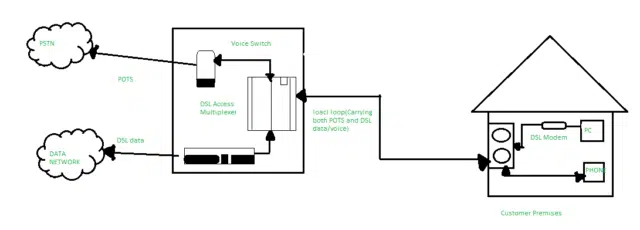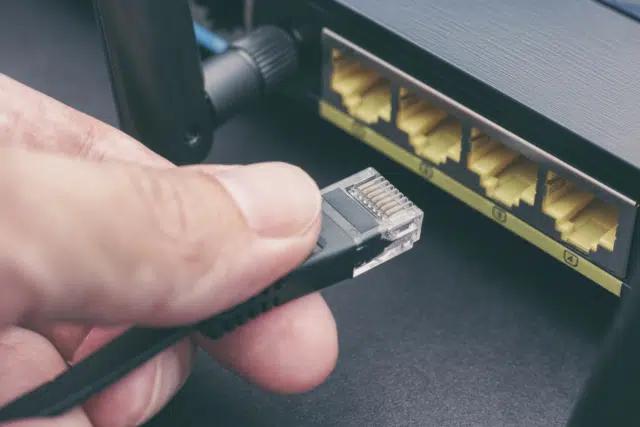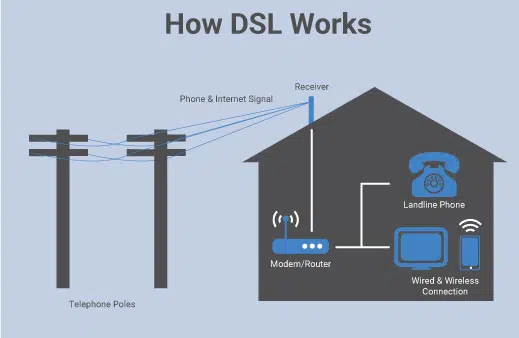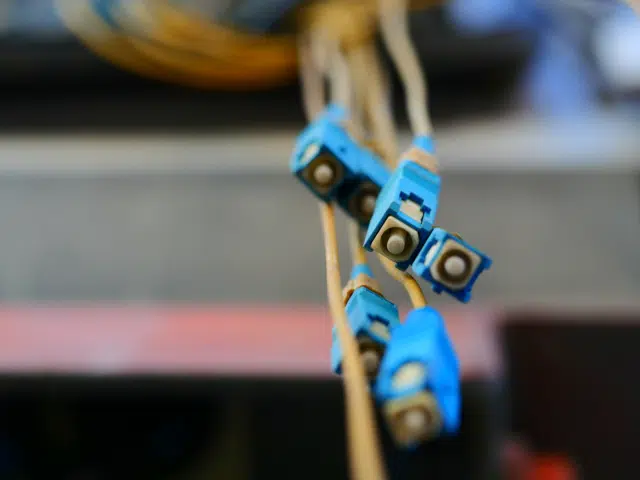What Is Digital Subscriber Line (DSL), How It Works, Benefits Explained
Learn about Digital Subscriber Line (DSL) and the significance of this high-bandwidth technology to the future of data transport.
Digital Subscriber Line (DSL)
Digital Subscriber Line (DSL), is a communication technique for high-speed network or Internet access over phone lines. DSL is used to transmit the internet through copper wire telephone lines. DSL is one of the most popular ways ISPs offer broadband internet connection, alongside cable. There are other types, such as asymmetric DSL (ADSL), high-bit-rate DSL (HDSL), symmetric DSL (SDSL), and very-high-bit-rate DSL (VDSL) (VDSL). Sometimes, the entire group is referred to as “xDSL.”
DSL is the primary form of broadband internet access and uses existing telephone wiring to transmit data via a DSL modem, making the internet accessible to all.
There are three types of DSL (collectively summarised as xDSL):
- ADSL: Asymmetric DSL provides faster download speeds. Receiving data is faster than sending data. Download speeds up to 20 Mbps and Upload up to 1.4 Mbps.
- SDSL: Symmetric DSL splits the incoming and outgoing frequencies equally, so upload and download bitrates are the same.
- VDSL: Very-high-speed Digital Subscriber Line—An upgrade on the prior HDSL, VDSL connects to extremely high frequencies providing download speeds of up to 52 Mbps and upload speeds of up to 16 Mbps. VDSL2 can provide speeds up to 100Mbps for both upload and download.
How does DSL work?
A DSL modem gets signals from the phone lines and turns them into digital ones so you can use them. You can get this information wirelessly or through an ethernet cable. DSL can be used in both cities and rural areas because it uses the phone lines that are already there. The capacity of phone lines is more than what is needed for phone calls, so DSL signals can easily use the same infrastructure.
The DSL modem or router is a separate device that can connect to multiple computers or mobile devices. Because DSL and your landline phone work on different frequencies, they don’t interfere with each other. Both phone and internet systems can work at the same time.
Compared to cellular data, DSL is a cheaper way to connect to the internet with high bandwidth. A high bitrate dial-up connection is much slower than this. Speeds range from 256 Kbps to 100 Mbps with DSL. Internet providers offer different packages based on how fast of a connection you need.
Businesses are moving to the cloud, which means that uploads and downloads from the cloud happen all the time and require a fast internet connection. Even though DSL is a good choice, there are other options to look into.

DSL vs Cable
Structure
Cable internet is a type of broadband internet that connects you to the internet through coaxial cables. It uses the same kind of infrastructure as cable TV, which is a lot like how DSL uses phone lines. Cable internet is popular with people who live in their own homes and is one of the more affordable choices.
Availability
Cable internet is almost as easily available as DSL. It’s widely accessible because of the reach of cable television especially in urban and suburban areas. You can easily find packages bundled with your cable TV monthly subscription.
There may be trouble getting it in rural areas. DSL can help because phone lines have reached places where cable still hasn’t.
Reliability
Cable internet can be unreliable when it comes to speed. Cable internet uses a shared network, and because it uses coaxial cables, the network can get backed up. This can cause speeds to slow down, and during busy times, performance can go down.
Speed
It’s among the fastest internet types out there. Download speeds can go up to 1 Gbps and upload up to 50 Mbps.

DSL vs Fixed Wireless Internet
Structure
Fixed wireless internet is a good option for rural and underserved areas that don’t have phone lines or cable TV. Towers send out signals that make up the internet. Think of a wireless modem that a whole town could use. The towers send data to receivers on a user’s property through waves of air. The best distance between the tower and the receiver is 10 miles. Between the access point on the tower and the receiver, there has to be a clear line of sight.
This is a great way to get high-speed broadband to places that are far away or don’t have access to telephone line networks. In general, it costs more than DSL. Fixed wireless internet, on the other hand, is easier to set up because it doesn’t need cables.
READ MORE:
- Learn more about the Pros and Cons of fixed wireless broadband
- Types of networks and how does it work
Availability
Fixed wireless internet is a solution to provide internet in areas without telephone infrastructure. Its availability would be dependent on a local business investing in creating the required infrastructure. Fixed wireless internet is not usually owned by big telephone providers. This makes it a little more expensive and less adaptive than other internet options.
Fixed wireless internet has always been an option for rural areas but lately some urban providers are using it to provide internet to entire apartment complexes.
Reliability
Fixed wireless service is mostly reliable. Since connection is made via airwaves, line of sight is required, so connection could be disturbed by buildings and other objects in the way. Rain, fog, and other weather conditions can deteriorate the signal strength and thus functionality.
Speed
Its speed ranges from 5Mbps to 50Mbps, which is the same or faster than DSL. You can stream videos, send large files over the internet, and use many other web-based tools with fixed wireless internet. Because the signal can be interrupted by things like weather, etc., speed can vary.
Also, providers offer generous data caps as compared to DSL providers.

DSL vs Fibre Optic Internet
Structure
Fiber optic internet is probably the best way to connect to the internet. A fiber optic cable sends data from the Internet to your home. These cables are made of thin strands of glass or plastic, and light pulses are used to send information. And everyone knows that light moves quickly, or at least that it moves quickly.
Just like everything on the internet, pulses carry binary data. One beat equals one, and no beat equals zero. This makes connections so fast that it’s hard to imagine, and it doesn’t matter how far away you are.
As with most good things in life, this is probably the most expensive internet option we have. Its prices have recently become more competitive, and when you think about how fast it is, it turns out to be a good way to connect to the internet for the money.
Fiber optic internet has a large bandwidth, which means it can keep up with growing populations and the use of public internet cloud.
Availability
Whether or not it’s available depends on whether or not a service provider has put in the work to lay fiber optic cables around your town or city. It’s a huge logistical challenge, and they also have to deal with annoying competition and lots of red tape. At the moment, big service providers only offer fiber optics in cities. The best chance you have of getting fiber optic internet is if your home or main office is in a big city.
Reliability
Reliability is better than all other ways to connect to the internet. Even when far away, the signal is reliable and stays the same. Optical amplifiers are used to make the signal stronger when sending data over thousands of miles. Copper wires and cables have higher attenuation, which makes the signal weaker.
Speed
Speed of fibre optic cables is naturally second to none. Download speeds can be as fast as 2 Gbps, which means you can download a 2-hour movie in under a minute. Upload speeds are also significantly faster than other types of internet connections.
Speed is consistently fast and you won’t expect a reduction in speed because of any interference or intrusion due to network congestion.

How to determine the right internet connection for you
The internet connection you choose will be dependent on a number of variables, some in your control and some that aren’t:
- The connections offered in your area depending on a rural or urban setting
- The internet service providers (ISPs) active in your area
- Your budget
- Your internet needs. Depending on if you need to use the internet for work, online learning, or for streaming movies.
- Your data cap. Large businesses process thousands of GBs of data every day and thus have a different requirement than a small business.
- Installation and equipment costs
- Overage fees
READ MORE:
- Know the best internet service provider near you
- What is bandwidth and it’s importance
- What is Voice Over Internet Protocol (VoIP)
- Top benefits of a DSL broadband internet explained
If you run a big or medium-sized business, you need to be aware of the problems with each technology and how they affect your business goals. Fast, reliable internet seems like a basic human need in the 21st century, but how fast and reliable it needs to be varies from organization to organization.
If you use the internet for VoIP calls and video conferencing, you would need faster speeds than a business that only uses landlines.
You should also think about how often you stream movies or TV shows when figuring out how much speed you need. And how many people in your home use the internet for meetings, games, streaming, etc.
People who study and work from home would also need fast upload speeds, especially for video conferences. Smart home devices can also use up a lot of bandwidth, so keep that in mind.
Also, you need to know that the speed your ISP says you’ll get is not the speed you’ll actually get. When comparing different service providers and their plans, make sure you know what speed you will actually get. The bandwidth of your ISP is another way to figure out how fast it is. Bandwidth is the amount of data that an ISP can handle per unit of time.
If your business can’t handle interruptions, you might want to look for an ISP that has a Service Level Agreement (SLA). An SLA is a service contract that guarantees a minimum level of service at all times. It tells you how reliable your internet connection is.
A physical problem with a piece of hardware or a broken line can easily mess up a stable internet connection. Think about getting an ISP that has great customer service, can help you get started, and knows how important it is to stay connected.

Getting the right internet connection can be the most important thing you do to connect your home or business to the internet. You should choose one that has fast speeds and prices that are fair. Carefully look at the pros and cons of each type of internet connection and make a decision after figuring out what you need from the internet.
Because DSL is so common, a lot of people choose to use it. Most cities and tech hubs have access to fiber optic. You can also get internet through cable, but DSL is better because it is more reliable. It’s hard to say whether DSL or cable is better because DSL can be cheaper but cable can be faster.
Depending on what’s available where you live, it’s easy to get fast, reliable internet these days. You can choose the best internet connection for your home or business from DSL, cable internet, fixed wireless internet, and fiber optic. Just do your research before jumping in.
How Does DSL Internet Work?
DSL lets you connect to the internet quickly by using the same wires as your phone. Most likely, your home or business already has telephone wires, so you don’t need to put in any new wiring. Only a DSL modem is needed, which DSL internet providers like download.zone will give you when you set up your service. The internet service provider sends signals to the modem through the phone line. The device gets the signals and changes them into the signal you need to use the internet.
There are many reasons to use DSL internet instead of dial-up, especially if you are worried about the slow speeds of dial-up. DSL connections to the internet are much faster and often cheaper because the wires needed are already in place. Just plug the modem into a phone jack to set it up quickly and easily.
Does DSL internet require an active phone line?
Nope! All you need are the wires. A DSL internet connection only needs phone line wires to receive internet signals and a modem to send the signals and give you access to the internet. You don’t even need to own a phone to set up a DSL connection. All you need is an internet connection. Installing DSL in a home or business is possible as long as there is a phone jack there.
How Fast Is DSL Internet?
There are different kinds of DSL services, and the main difference between them is how fast you can download and how fast you can upload. Most people use asymmetrical DSL, which is also known as ADSL. This type has a higher download bandwidth than an upload bandwidth. Most people who use the internet download much more than they upload, so this type is the one that is bought the most. The other type of DSL connection is symmetrical, which is also known as SDSL. It has the same amount of bandwidth for sending and receiving, which makes it faster to download and upload.
There are also newer, faster versions of DSL technology, like ADSL2+, which is an improved version of ADSL that offers faster speeds. On the scale of faster DSL speeds, there are two more options: very high-speed DSL, which works faster than ADSL2+, and VDSL2, which is the fastest DSL connection of all.
Choosing between different types of DSL really depends on how often you connect to and use the internet. download.zone has a DSL plan that costs only one low price.
Fiber-optic internet plans are also available from download.zone . These plans offer faster speeds, almost no lag in video chats, and easy data backup. Among them are:
- 500 Mbps: This connection has a speed capable range as fast as 500 Mbps and upload speeds as much as 25x faster than cable internet connections. It allows for enough power to support internet browsing, streaming, gaming and other work/school activities, such as video conferencing.
- Gig Service: This network connection has the fastest speeds and largest bandwidth, with upload and download speeds that are symmetrical. This is the ideal service for the tech-savvy, heavy internet users.
Is DSL Internet Reliable?
DSL services are a good choice for home internet because they are reliable and don’t cost too much. They can easily handle the activities of the average internet user. The speed is always the same, so you don’t have to worry about delays even when a lot of people are using it at once. With a DSL connection, your bandwidth is safe and secure, and it won’t be shared with people outside of your network. This also makes it safer for kids to use the internet at home.
DSL is a good choice for people who live in rural areas because it uses the phone lines that are already there. Most of the time, the price is much lower, and the speeds in small towns are better than with other options. When you live in a small town, it’s important to have a reliable way to connect to the internet because there may not be many Wi-Fi hot spots or other ways to connect.
How to get DSL Internet In your Home
With download.zone as your ISP, it’s easy to set up DSL internet at home. When you place an order online, you might even be able to get special deals like free service activation. The DSL installation is done by trained professionals and will include everything you need to start using faster, more reliable internet.
There are no limits on how much data or how much you can use with download.zone Internet service. Once you have everything set up, you can connect to the internet as often and whenever you want. Our easy-to-understand pricing makes each internet plan affordable and easy to use. We also offer unlimited tech support via text, email, or social media 24 hours a day, seven days a week.
What Are The Advantages of DSL?
Most of the time, you probably wouldn’t want DSL unless your only other option was cheap, old-fashioned dial-up service, which is still available in many places. DSL is better than dial-up in the following ways:
- You can use the Internet and talk on the phone at the same time.
- It works quicker than dial-up.
- You can choose between different price plans depending on how fast you want or are willing to go.
That seems like a good start, but there are some disadvantages nonetheless:
- Sending data won’t work as well or as fast as receiving data.
- The further you are from the telephone company’s central location, the slower your service might be (we’re not talking hundreds of miles either—more like just under four miles).
- Sorry. You just might be too far away to even be offered DSL.
Conclusion
It’s hard to believe that most people and families would be happy with slow Internet service if there was another way to connect to the Internet. On the other hand, most people just stick to what they know.
If you have DSL and find it annoying, you might want to check to see if a cable company (like Cox, Time-Warner, etc.) offers high-speed Internet.
If you already have cable but don’t like their prices, you might want to switch to DSL to save money.
But then you’d have to deal with the limits of DSL.


Comments are closed.